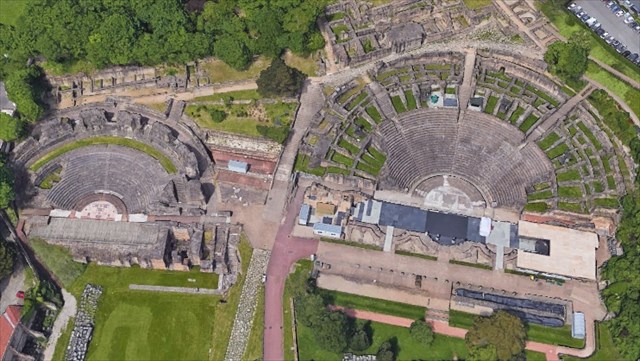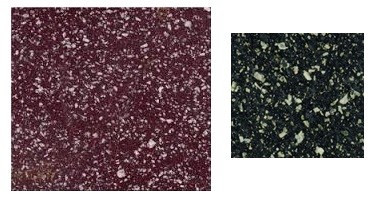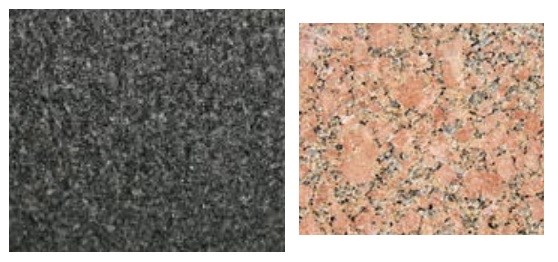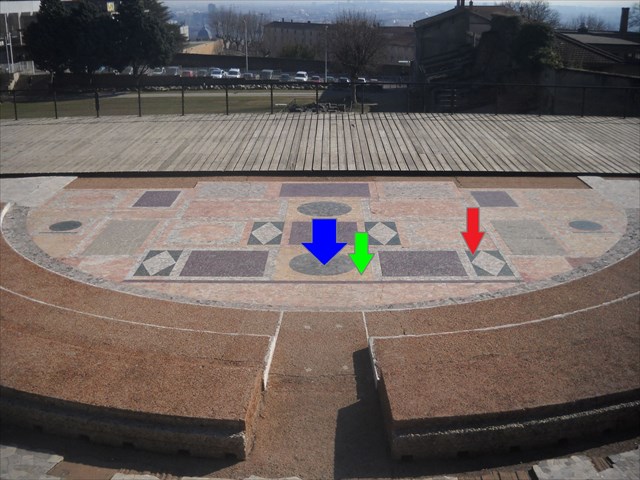
Lugdunum, capitale des Gaules était une cité qui, comme Vienne tout proche, disposait d’équipements culturels exceptionnels, avec à la fois un théâtre et un odéon (petit théâtre dédié à la musique) ce qui était rare.

Le pavement de l’orchestra, espace demi-circulaire situé au pied de la scène, était un exemple de ce qui se faisait de plus beau dans l’empire : avec utilisation conjointe de marbres, prophyres, granites venus de tout le bassin méditerranéen (Grèce, Turquie, Egypte et Tunisie). Les carrières utilisées dépendaient directement de l’empereur pour leur exploitation. Ce pavement, datant du IIème siècle, a été restauré il y a quelques années et s’avère être un des plus beaux de la Gaule romaine. A travers cette earthcache, je vous propose de découvrir les différents matériaux de construction utilisés pour ce pavement (ainsi que quelques pierres de décoration de l’odéon et une pierre particulière de la voie romaine), leur origine, leurs caractéristiques et apprendre à les reconnaître.
Le marbre
Le marbre, pour le géologue, est une roche issue de la transformation (recristallisation) d’une roche sédimentaire carbonatée (calcaire, marne…). On parle aussi de roche métamorphique. Elle est principalement constituée de cristaux de calcite, donc des cristaux blancs. Mais la roche peut prendre différents coloris. Elle comporte de plus des veines appelées marbrures. Les coloris et marbrures sont dus à des inclusions d’oxydes métalliques. La transformation de la roche s’est faite sous l’effet d’une forte pression (et température). Les structures sédimentaires sont alors effacées et la roche carbonatée recristallise en un amas de cristaux de calcite. Les grains formés et agglutinés ont des dimensions de l’ordre du mm ou du cm. On parle de grains fins.
Le marbre a une schistosité prononcée, c'est-à-dire que sa structure s’organise sous forme de feuilles, ce qui facilite et ordonne sa découpe selon des plans bien particuliers.
Le mot marbre vient du grec « marmaros » qui signifie « pierre resplendissante ». C’est en effet une pierre dont la surface peut être lustrée avec un polissage. La pierre reflète alors la lumière. C’est la pierre qui donnera le plus beau polissage et donc reflet de la lumière.
Sur le pavement de l’odéon, on trouve des marbres jaunes de Tunisie, violet et vert de Turquie (à ne pas confondre avec les porphyres verts – voir ci-dessous)

-->En pratique : le marbre se reconnait par l’aspect homogène de sa couleur (faible dégradé), son polissage. Et par la présence de marbrures, lignes plus claires ou sombre. Pour le marbre blanc, on distingue facilement des points brillants qui sont des cristaux de calcite et la couleur blanche est assez homogène.
Le porphyre
Le porphyre désigne une roche magmatique qui présente une texture caractérisée par de grands cristaux de feldspath noyés dans une pâte aphanitique (c'est-à-dire une pâte qui ne montre pas de cristaux à l’œil nu). Le mot porphyre vient de la couleur pourpre, car à l’origine, on extrayait les porphyres rouges antiques dans le désert oriental égyptien (Djebel Dhokan). C’était une roche très prestigieuse. On en faisait des vasques, des sculptures, de très grandes colonnes, des sarcophages, des pavements…Cette roche symbolisait la puissance impériale et était utilisée pour les monuments liés à l’empereur.
Il existe aussi le porphyre vert antique qui provient de la Grèce (Péloponnèse), et exploité depuis -1700 ans avant JC. On le recherchait aussi beaucoup au Moyen-Age et à la Renaissance. Extrait sous forme de petits blocs, on en faisait de petites colonnes, des vases, des pavements, des mosaïques…
C’est une roche très dure, bien plus que le marbre. Il fallait des années pour travailler cette pierre.
Sur le pavement de l’odéon, on trouve des porphyres

-->En pratique : le porphyre se reconnait par la présence de gros grains (feldspath) répartis de manière non homogène au milieu d’une pâte. On retrouve la présence de grains plus claires, dont la taille peut aller jusqu’au cm au milieu d’une pâte plus sombre.Il est à noter que contrairement à du granite (voir-dessous), les grains de feldspath sont plus gros et de tailles et formes bien plus irrégulières que ceux du granite, vu de près.
Le granite
Le granite désigne une roche est une roche plutonique magmatique à texture grenue, caractérisée par sa constitution en minéraux: quartz, feldspaths potassiques (orthoses) et plagioclases, micas (biotite ou muscovite).
Une roche magmatique plutonique est formée par le refroidissement lent du magma (plusieurs dizaines de milliers d’années). Elle se traduit par la formation de gros cristaux, visibles à l’œil nu. Le granite appartient à la famille des roches leucocrates, c'est-à-dire qui comportent entre 12,5% et 37,5% de minéraux clairs (quartz, feldspaths et feldspathoïdes) opposés aux minéraux foncés (ferromagnésiens : olivine et pyroxènes). Ainsi, la roche a une couleur plutôt claire, ici grise. Mais on peut aussi en trouver de couleurs jaunâtre, bleuâtre, rougeâtre, rosâtre… On les trouve en France dans les massifs montagneux jeunes (ex : Alpes) ou vieux (ex : massif armoricain). C’est une roche qui affleure après que l’érosion est fait son œuvre.
En terme de construction, le granite est classé numéro 1 en terme de dureté et de longévité. Il est d’autant plus dur qu’il contient beaucoup de quartz et peu de mica. En revanche, la présence de mica permet de le polir, à un point tel que son éclat peut atteindre celui du marbre. Le granite a été souvent utilisé pour faire des colonnes, des obélisques, des piédestaux qui ont bien tenu dans le temps (cf les restes des monuments retrouvés aujourd’hui). Et aujourd’hui on le trouve sur toutes les bordures de trottoir.
Sur le pavement de l’odéon, on trouve du granite gris d’Egypte, provenant des environs d’Assouan : c’est le syenite. Le mica est remplacé par de l’amphibole (autre forme et aspect que le mica). L’obélisque de Louxor qui trône place de la Concorde à Paris, provient du même granite. On peut penser que ce granite égyptien bénéficiait d’un grand prestige, ayant permis la construction de nombreux monuments des pharaons qui ont défié le temps.

-->En pratique : le granite (gris) se reconnait à l’œil nu par sa texture granuleuse fine et régulière, avec alternance de points sombres et clairs, de tailles régulières et assez identiques, moins fins que le marbre, mais plus fins que le porphyre. Selon les morceaux de provenance du granite, l’intensité du gris (sombre ou clair) peut varier.
Sources : Wikipedia Marbre / Porphyre / Granite / Granite utilisé en construction
Pour répondre à cette earthcache :

1/ Décrire pour chaque flèche colorée :
L’aspect de la pierre (couleurs observées, aspect de surface) et conclure sur la nature de la pierre concernée (marbre ou porphyre ou granite)
2/ Au point R1, vous trouverez une plaque explicative (qui pourra éventuellement vous aider partiellement pour le 1/). 5 provenances des matériaux utilisés pour le pavement sont mentionnées sur une carte du bassin méditerranéen. A quelles chiffres (dans l’ordre) correspondent : la Grèce / la Turquie / la Tunisie ?
3/ Se rendre au point R2, à l’entrée des vestiges romains.

Ici passait une voie romaine. Toutes les pierres sont en granite, pour résister aux passages répétés des chars. Sauf une pierre (rectangle bleu).
Est-ce un porphyre ou un marbre ? Elle porte une (ou des) couleur(s) particulière(s) à plusieurs endroits : laquelle(s) ?
Les sites archéologiques sont ouverts :
- De 7h à 19h du 16 septembre au 14 avril
- De 7h à 21h du 15 avril au 15 septembre
Rappel concernant les Earthcaches : il n'y a pas de contenant à trouver ni de logbook à signer.
Loguez un "found it" et envoyez-moi vos réponses soit via mon profil, soit via la messagerie du site.
Je vous contacterai en cas de problème.
Tout log enregistré sans envoi des réponses sera supprimé.
-------------------------------------------------------------------------------------------------

Lugdunum, capital of the Gauls was a city which, as quite close Vienna, had exceptional cultural facilities, with at the same time a theater and an odéon (small theater dedicated in music) what was rare.

The pavement of orchestrated him, half-circular space situated at the foot of the scene, was an example of what was made of more beautiful in the empire: with joint marble use, prophyres, granitelike come from all the Mediterranean Basin (Greece, Turkey, Egypt and Tunisia). The used careers depended directly on the emperor for their exploitation. This pavement, dating the IIth century, was restored a few years ago and turns out to be one of more beautiful of the Roman Gaul. Through this earthcache, I suggest you discovering the various building materials used for this pavement (as well as some stones of decoration of the odéon and particular stone of the Roman way), their origin, their characteristics and learning to recognize them.
The marble
The marble, for the geologist, is a rock stemming from the transformation (recrystallising) of a carbonate sedimentary rock (limestone, marl …). We also speak about metamorphic rock. She is mainly established by crystals of calcite, thus crystals white. But the rock can take various colors. She contains more veins called marblings. The colors and the marblings are owed to inclusions of metal oxides. The transformation of the rock was made under the influence of strong pressure (and temperature). The sedimentary structures are then erased and the carbonate rock recrystallized in a heap of crystals of calcite. The formed and agglutinated grains have dimensions of the order of the mm or the cm. We speak about fine grains.
The marble has a pronounced schistosité, that is its structure gets organized in the form of leaf, what facilitates and orders its cut according to very particular plans.
The word marbles comes of greek "marmaros" which means" radiant stone". It is indeed stone the surface of which can be polished with a polishing. Stone reflects then the light. It is stone which will give the most beautiful polishing and thus the reflection of the light.
On the pavement of the odéon, we find marble yellow of Tunisia, purple and green of Turkey (not to confuse with porphyries greens - to see below)

-->En pratique : the marble reknows by the homogeneous aspect of its color (low gradation), its polishing. And by the dark or clearer presence of marblings, lines. For the marble white, we distinguish easily brilliant points which are crystals of calcite and the color white is rather homogeneous.
Porphyry
Porphyry indicates a magmatic rock which presents a texture characterized by of big crystals of feldspar bathed in a dough aphanitique (that is a dough which does not show crystals to the naked eye). The word porphyry comes from the purple color, because originally, we extracted porphyries antique red in the Egyptian oriental desert (Djebel Dhokan). It was a very prestigious rock. We made it bowls, sculptures, very big columns, sarcophaguses, pavements … This rock symbolized the imperial power and was used for monuments bound to the emperor.
There is also porphyry antique green which results from Greece (Peloponnese), and exploited for -1700 years before JC. We also looked for him very in the Middle Ages and in the Renaissance. Extracted in the form of small blocks, we made it of small columns, vases, pavements, mosaics …
It is a very hard rock, much more than a marble. Years were needed to work this stone.
On the pavement of the odéon, we find porphyries

-->In practice: porphyry reknows by the presence of coarse grit (feldspar) distributed in way homogeneous no in the middle of a dough. We find the clearer presence of grains, the size of which can go up to the cm in the middle of a darker dough. It should be noted that contrary to some granite (see below), the grains of feldspar are bigger and of sizes and forms more irregular than those some granite, seen closely.
The granite
The granite indicates a rock magmatic plutonique in grainy texture, characterized by its constitution in minerals: quartz, potassium feldspars orthoses ) and plagioclases, micas (biotite or muscovite). A plutonic magmatic rock is formed by the slow cooling of the magma (several tens of thousands of years). She is translated by big person's training crystals, visible to the naked eye. The granite belongs to the family of rocks leucocrates, that is which contain between 12,5 % and 37,5 % of clear minerals (quartz, feldspars and feldspathoïdes) opposite to dark minerals (ferromagnésiens : olivines and pyroxènes). So, the rock has a rather clear color, here grey. But we can also find there of yellowish, bluish, reddish, pinkish colors … We find them in France in the young mountain massifs (ex: The Alps) or old man (ex: Armorican massif). It is the rock which appears after the erosion is made its work.
In term of construction, the granite is classified number 1 in term of hardness and longevity. He is hard all the more as he contains many quartz and few mica. On the other hand, the presence of mica allows to polish him, to such a point that its brightness can reach that of the marble. The granite was often used to make columns, obelisks, bases which held well in the time (cf the rests of monuments found today). And today we find him on all the curbstones.
On the pavement of the odéon, we find some granite grey of Egypt, resulting from neighborhood of Aswan: it is the syenite. The mica is replaced by the amphibole (other forms and aspect that the mica). The obelisk of Luxor which thrones place de la Concorde in Paris, results from the same granite. We can think that this Egyptian granite benefited from a big prestige, having allowed the construction of numerous monuments of the Pharaohs which challenged the time.

-->En pratique : the granite (grey) reknows to the naked eye by its fine and regular granular texture, with alternation of dark and clear regular and rather identical points, sizes, less fine than the marble, but finer than porphyry. According to the pieces of origin of the granite, the intensity of grey (dark or clear) can vary.
Sources: Wikipedia Marbre / Porphyry / Granite / Granite used under construction
To answer this earthcache :

1/ Describe for every coloured arrow :
The aspect of stone (observed colors, aspect of surface) and end on the nature of stone concerned (marble or porphyry or granite)
2/In the point R1, you will find explanatory plate (which can possibly help you partially for 1/). 5 origins of materials used for the pavement are mentioned on a card of the Mediterranean Basin. To which amount (in the order) correspond: Greece / Turkey / Tunisia?
3/ Go to the point R2, to the entrance of the Roman vestiges.

Here crossed a Roman way. All stones are in granite, to resist the passages repeated of tanks. Except stone (rectangle blue).
Is it one porphyry or a marble? She carries one (or) particular color (s) in several places: which one (s)?
Archeological sites are opened:
- From 7 am till 7 pm from September 16th till April 14th
- From 7 am till 9 pm from April 15th till September 15th
Reminder concerning Earthcaches: there is not of containing neither to find nor of logbook to sign.
Loguez one "found it" and send me your answers either via my profile, or via the messaging of the site.
I shall contact you in case of problem.
Any recorded log without sending of the answers will be deleted.